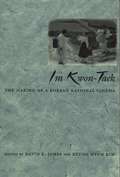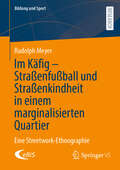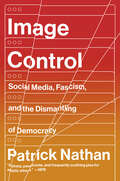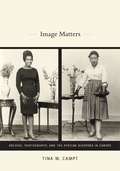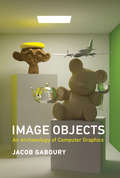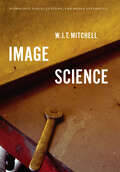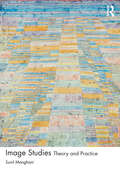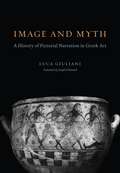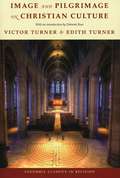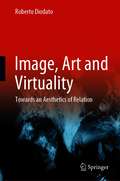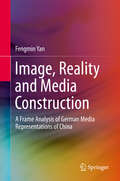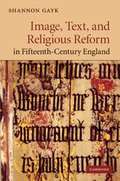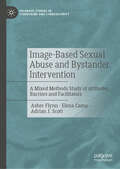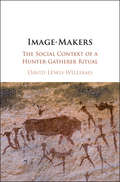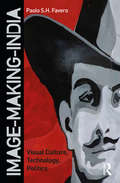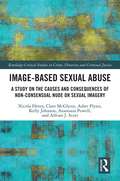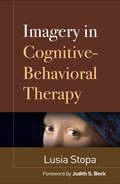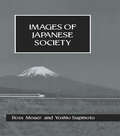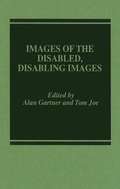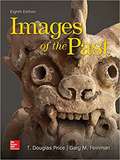- Table View
- List View
Im Kwon-Taek: The Making of a Korean National Cinema
by Kyung Hyun Kim David E. JamesKorean cinema was virtually unavailable to the West during the Japanese colonial period (1910-1945), and no film made before 1943 has been recovered even though Korea had an active film-making industry that produced at least 240 films. For a period of forty years, after Korea was liberated from colonialism, a time where Western imports were scarce, Korean cinema became an innovative force reflecting a society whose social and cultural norms were becoming less conservative. Im Kwon-Taek: The Making of a Korean National Cinema is a colleciton of essays written about Im Kwon-Taek, better know as the father of New Korean Cinema, that takes a critical look at the situations of filmmakers in South Korea. Written by leading Koreanists and scholars of Korean film in the United States, Im Kwon-Taek is the first scholarly treatment of Korean cinema. It establishes Im Kwon-Taek as the only major Korean director whose life's work covers the entire history of South Korea's military rule (1961-1992). It demonstrates Im's struggles with Korean cinema's historical contradictions and also shows how Im rose above political discord. The book includes an interview with Im, a chronology of Korean cinema and Korean history showing major dynastic periods and historical and political events, and a complete filmography. Im Kwon-Taek is timely and makes a significant contribution to our understanding of Korean cinema. These essays situate Im Kwon-Taek within Korean filmmaking, placing him in industrial, creative, and social contexts, and closely examine some of his finest films. Im Kwon-Taek will interest students and scholars of film studies, Korean studies, religious studies, postcolonial studies, and Asian studies.
Im Käfig - Straßenfußball und Straßenkindheit in einem marginalisierten Quartier: Eine Streetwork-Ethnographie (Bildung und Sport #38)
by Rudolph MeyerDer Straßenfußball im marginalisierten Quartier ist eher im Sinne eines Trendsports als Konglomerat aus Stilen und virtuosen Tricks zu begreifen, als im Sinne des vereinsorientierten Wettkampfsportes. Dabei werden tendenziell heteronormative und dominanzorientierte Männlichkeitsnormen (re)produziert. Die Kinder sehen sich vielgestaltigen Konflikten zum Beispiel mit älteren Kindern und Jugendlichen, Eltern oder Straßenszenen sowie Polizei und Ordnungsamt ausgesetzt. Die in diesem Buch dargestellten Spielformen, Normen und Konflikte erweitern den Blick der sportpädagogischen Kindheits- und Jugendforschung und geben zugleich Hinweise für die Gestaltung der Offenen Kinder- und Jugendarbeit.
Im Sinne der Medien – Textverständlichkeit im Nachrichtenauswahlkontext
by Claudia ThomsKann Verständlichkeit zum Erfolg der Presse- und Medienarbeit beitragen? Oder anders gefragt: Welche Rolle spielt Verständlichkeit bei der journalistischen Nachrichtenauswahl? Ausgehend vom Konzept der Mediatisierung argumentiert die Studie, dass die Beachtung grundlegender Verständlichkeitsregeln als ein strategisches Mittel zur Beeinflussung der medialen Aufmerksamkeit angesehen werden kann. Denn Verständlichkeit als journalistisches Qualitätskriterium ist Teil der Medienlogik. Wer diese Medienlogik bei der Gestaltung der eigenen Kommunikation berücksichtigt, schreibt im Sinne der Medien und entspricht journalistischen Vorstellungen darüber, was überhaupt berichterstattenswert ist und wie über entsprechende Ereignisse zu berichten ist. Grundlage zur empirischen Überprüfung dieser Annahme ist eine input-output-analytische Untersuchung von Pressemitteilungen DAX-notierter Unternehmen sowie der daraus resultierenden Berichterstattung in ausgewählten Medien. Mit einer Kombination manueller und automatisierter Formen der Inhaltsanalyse wird dabei die sprachliche Komplexität der Pressemitteilungen bestimmt und die Wirkung dieser Komplexität auf den journalistischen Umgang mit den Pressemitteilungen untersucht.
Im Spannungsverhältnis zwischen Selbst- und Fremdverstehen: Globale Herausforderungen und deutsch-chinesische Kulturbeziehungen
by Chunchun Hu Thomas Zimmer Odila TriebelDieser Open-Access-Sammelband hinterfragt, wie sich internationale Kulturzusammenarbeit zwischen Ländern unterschiedlicher Kultursysteme und -traditionen erreichen lässt. In Deutschland ist Auswärtige Kulturpolitik von dem Gedanken geleitet, dass globale Herausforderungen Multilateralismus erfordern. Im chinesischen Diskurs dagegen finden andere Kernbegriffe wie z.B. „Tianxia“ Verwendung, die im nicht-chinesischen Kontext einer Interpretation bedürfen. Um der Differenz – aber auch den Gemeinsamkeiten – auf den Grund zu gehen, untersuchen Wissenschaftler*innen und Praktiker*innen aus China und Deutschland Selbst- und Fremdwahrnehmungen sowie Kooperationen in kulturellen Begegnungen. Auf diese Weise sollen Grundlagen für ein besseres gegenseitiges Verständnis sowie für kulturelle Kooperation zwischen beiden Ländern ermöglicht werden.
Image Control: Art, Fascism, and the Right to Resist
by Patrick NathanSusan Sontag meets Hanif Abdurraqib in this fascinating exploration of the unexpected connections between how we consume images and the insidious nature of Fascism.Images come at us quickly, often without context. A photograph of Syrian children suffering in the wake of a chemical attack segues into a stranger&’s pristine Instagram selfie. Before we can react to either, a new meme induces a laugh and a share. While such constant give and take might seem innocent, even entertaining, this barrage of content numbs our ability to examine critically how the world, broken down into images, affects us. Images without context isolate us, turning everything we experience into mere transactions. It is exactly this alienation that leaves us vulnerable to fascism—a reactionary politics that is destroying not only our lives and our nations, but also the planet&’s very ability to sustain human civilization. Who gets to control the media we consume? Can we intervene, or at least mitigate the influence of constant content? Mixing personal anecdotes with historical and political criticism, Image Control explores art, social media, photography, and other visual mediums to understand how our culture and our actions are manipulated, all the while building toward the idea that if fascism emerges as aesthetics, then so too can anti-fascism. Learning how to ethically engage with the world around us is the first line of defense we have against the forces threatening to tear that world apart.
Image Matters: Archive, Photography, and the African Diaspora in Europe
by Tina M. CamptIn Image Matters, Tina M. Campt traces the emergence of a black European subject by examining how specific black European communities used family photography to create forms of identification and community. At the heart of Campt's study are two photographic archives, one composed primarily of snapshots of black German families taken between 1900 and 1945, and the other assembled from studio portraits of West Indian migrants to Birmingham, England, taken between 1948 and 1960. Campt shows how these photographs conveyed profound aspirations to forms of national and cultural belonging. In the process, she engages a host of contemporary issues, including the recoverability of non-stereotypical life stories of black people, especially in Europe, and their impact on our understanding of difference within diaspora; the relevance and theoretical approachability of domestic, vernacular photography; and the relationship between affect and photography. Campt places special emphasis on the tactile and sonic registers of family photographs, and she uses them to read the complexity of "race" in visual signs and to highlight the inseparability of gender and sexuality from any analysis of race and class. Image Matters is an extraordinary reflection on what vernacular photography enabled black Europeans to say about themselves and their communities.
Image Objects: An Archaeology of Computer Graphics
by Jacob GabouryHow computer graphics transformed the computer from a calculating machine into an interactive medium, as seen through the histories of five technical objects.Most of us think of computer graphics as a relatively recent invention, enabling the spectacular visual effects and lifelike simulations we see in current films, television shows, and digital games. In fact, computer graphics have been around as long as the modern computer itself, and played a fundamental role in the development of our contemporary culture of computing. In Image Objects, Jacob Gaboury offers a prehistory of computer graphics through an examination of five technical objects--an algorithm, an interface, an object standard, a programming paradigm, and a hardware platform--arguing that computer graphics transformed the computer from a calculating machine into an interactive medium. Gaboury explores early efforts to produce an algorithmic solution for the calculation of object visibility; considers the history of the computer screen and the random-access memory that first made interactive images possible; examines the standardization of graphical objects through the Utah teapot, the most famous graphical model in the history of the field; reviews the graphical origins of the object-oriented programming paradigm; and, finally, considers the development of the graphics processing unit as the catalyst that enabled an explosion in graphical computing at the end of the twentieth century. The development of computer graphics, Gaboury argues, signals a change not only in the way we make images but also in the way we mediate our world through the computer--and how we have come to reimagine that world as computational.
Image Science: Iconology, Visual Culture, and Media Aesthetics
by W.J.T. MitchellAlmost thirty years ago, W. J. T. Mitchell's Iconology helped launch the interdisciplinary study of visual media, now a central feature of the humanities. Along with his subsequent Picture Theory and What Do Pictures Want?, Mitchell's now-classic work introduced such ideas as the pictorial turn, the image/picture distinction, the metapicture, and the biopicture. These key concepts imply an approach to images as true objects of investigation--an "image science. " Continuing with this influential line of thought, Image Science gathers Mitchell's most recent essays on media aesthetics, visual culture, and artistic symbolism. The chapters delve into such topics as the physics and biology of images, digital photography and realism, architecture and new media, and the occupation of space in contemporary popular uprisings. The book looks both backward at the emergence of iconology as a field and forward toward what might be possible if image science can indeed approach pictures the same way that empirical sciences approach natural phenomena. Essential for those involved with any aspect of visual media, Image Science is a brilliant call for a method of studying images that overcomes the "two-culture split" between the natural and human sciences.
Image Studies: Theory and Practice
by Sunil ManghaniImage Studies offers an engaging introduction to visual and image studies. In order to better understand images and visual culture the book seeks to bridge between theory and practice; asking the reader to think critically about images and image practices, but also simultaneously to make images and engage with image-makers and image-making processes. Looking across a range of domains and disciplines, we find the image is never a single, static thing. Rather, the image can be a concept, an object, a picture, or medium – and all these things combined. At the heart of this book is the idea of an ‘ecology of images’, through which we can examine the full ‘life’ of an image – to understand how an image resonates within a complex set of contexts, processes and uses. Part 1 covers theoretical perspectives on the image, supplemented with practical entries on making, researching and writing with images. Part 2 explores specific image practices and cultures, with chapters on drawing and painting; photography; visual culture; scientific imaging; and informational images. A wide range of illustrations complement the text throughout and each chapter includes creative tasks, keywords (linked to an online resource), summaries and suggested further reading. In addition, each of the main chapters include selected readings by notable authors across a range of subject areas, including: Art History, Business, Cognitive Science, Communication Studies, Infographics, Neuroscience, Photography, Physics, Science Studies, Social Semiotics, Statistics, and Visual Culture.
Image Testimonies: Witnessing in Times of Social Media (Routledge Studies in Affective Societies)
by Kerstin Schankweiler Verena Straub Tobias WendlRecent political conflicts signal an increased proliferation of image testimonies shared widely via social media. Although witnessing with and through images is not a phenomenon of the internet era, contemporary digital image practices and politics have significantly intensified the affective economies of image testimonies. This volume traces the contours of these conditions and develops a conception of image testimony along four areas of focus. The first and second section of this volume reflects the discussion of image testimonies as an interplay of evidential qualities and their potential to express affective relationalities and emotional involvement. The third section focuses on the question of how social media technologies shape and subsequently are shaped by image testimonies. To further complicate the ethical position of the witness, the final section looks at image testimony at the intersection of creation and destruction, taking into account the perspectives of different actors and their opposed moral positions. With an emphasis on the affectivity of these images, Image Testimonies provides new and so far overlooked insights in the field. It will appeal to students and researchers interested in fields such as Sociology and Social Policy, Media and Communications, Visual Arts and Culture and Middle East Studies.
Image and Myth: A History of Pictorial Narration in Greek Art
by Luca Giuliani translated by Joseph O'DonnellOn museum visits, we pass by beautiful, well-preserved vases from ancient Greece but how often do we understand what the images on them depict? In "Image and Myth," Luca Giuliani tells the stories behind the pictures, exploring how artists of antiquity had to determine which motifs or historical and mythic events to use to tell an underlying story while also keeping in mind the tastes and expectations of paying clients. Covering the range of Greek style and its growth between the early Archaic and Hellenistic periods, Giuliani describes the intellectual, social, and artistic contexts in which the images were created. He reveals that developments in Greek vase painting were driven as much by the times as they were by tradition the better-known the story, the less leeway the artists had in interpreting it. As literary culture transformed from an oral tradition, in which stories were always in flux, to the stability of written texts, the images produced by artists eventually became nothing more than illustrations of canonical works. At once a work of cultural and art history, "Image and Myth" builds a new way of understanding the visual culture of ancient Greece. "
Image and Pilgrimage in Christian Culture (Columbia Classics in Religion #Vol. 11)
by Victor Turner Edith TurnerFirst published in 1978, Image and Pilgrimage in Christian Culture is a classic work examining the theological doctrines, popular notions, and corresponding symbols and images promoting and sustaining Christian pilgrimage. The book examines two major aspects of pilgrimage practice: the significance of context, or the theological conditions giving rise to pilgrimage and the folk traditions enabling worshippers to absorb the meaning of the event; and the images and symbols embodying the experience of pilgrimage and transmitting its visions in varying ways. Retelling its own tales of "mere mortals" confronted by potent visions, such as the man Juan Diego who found redemption with the Lady of Guadalupe and the poor French shepherdess Bernadette whose encounter with the Lady at Lourdes inspired Christians across the globe, this text treats religious visions as both paradox and empowering phenomena, tying them explicitly to the times in which they occurred. Offering vivid vignettes of social history, it extends their importance beyond the realm of the religious to our own conceptions of reality.Extensively revised throughout, this edition includes a new introduction by the theologian Deborah Ross situating the book within the work of Victor and Edith Turner and among the movements of contemporary culture. She addresses the study's legacy within the discipline, especially its hermeneutical framework, which introduced a novel method of describing and interpreting pilgrimage. She also credits the Turners with cementing the link between mysticism, popular devotion, and Christian culture, as well as their recognition of the relationship between pilgrimage and the deep spiritual needs of human beings. She concludes with various critiques of the Turners' work and suggests future directions for research.
Image, Art and Virtuality: Towards an Aesthetics of Relation
by Roberto DiodatoThis book investigates the ontological state of relations in a unique way. Starting with the notion of system, it shows that the system can be understood as a relational structure, and that relations can be assessed within themselves, with no need to transform relations in elements. “Relations” are understood in contrast to “relational property”: without a relation there is no identity, therefore no existence. What allows us to do that without hypostatizing the relation, and without immediately taking it simply as a causal relation, can be better grasped, possibly, in reference to a few entities that make best display of their systemic nature, for example images, works of art, and virtual bodies.This book shows how virtual bodies are ontological hybrids representing a type of entity that has never appeared in the world before. This entity becomes a phenomenon in interactivity and evades the dichotomy between “external” and “internal”; it is neither a cognitive product of the consciousness, nor an image of the mind. The user is well aware of experiencing anotherreality, also in the sense of a paradoxical reduplication of perceptual synthesis. The virtual body-environment is therefore simultaneously external and internal, with virtual bodies-environments to be seen as artificial windows to an intermediary world. In this intermediary world, the space itself is the result of interactivity; the world takes place in the sense or feeling of immersion experienced by the user; and the body, perceived as “other”, takes upon itself the sense of its reality, of its effectiveness, as an imaginary and pathic incision, as a production of desire and emotion, to the point that the feeling of reality conveyed by a virtual environment will rely significantly on how this environment produces emotions in the users.
Image, Reality and Media Construction: A Frame Analysis of German Media Representations of China
by Fengmin YanThis book explores how news media construct social issues and events and thereby convey certain perceptions within the scope of framing theory. By operationalizing media framing as a process of interpretation through defining problem, diagnosing causes, making moral judgments and suggesting solutions, the book proposes a systematic and transparent approach to images in news discourse. Based on a frame analysis, it examines how German news media framed a list of China-related issues and events, and thereby conveyed particular beliefs and opinions on this country. Moreover, it investigates whether there were dominant patterns of interpretation and the extent to which diverse views were evident by comparing two major daily newspapers with opposite political orientations - the FAZ and the taz. Motivated by the relationship between image and reality, the book explores image formation and persistence from media construction of meaning and human cognitive complexity in perceiving others. Media select certain issues and events and then interpret them from particular perspectives. A variety of professional and non-professional factors behind news making may result in biased representations. In addition, from a social psychological perspective, inaccurate perceptions of foreign cultures may arise from categorical thinking, biased processing of stimulus information, intergroup conflicts of interest and in-group favoritism.Accordingly, whether media coverage deviates from reality is not the main concern of this book; instead, it emphasizes the underlying logics upon which the conclusions and judgments were drawn. It therefore contributes to a rational understanding of Western discourse and holds practical implications for both Chinese public diplomacy and a more constructive role of news media in promoting the understanding of others.
Image, Text, and Religious Reform in Fifteenth-Century England
by Shannon GaykFocusing on the period between the Wycliffite critique of images and Reformation iconoclasm, Shannon Gayk investigates the sometimes complementary and sometimes fraught relationship between vernacular devotional writing and the religious image. She examines how a set of fifteenth-century writers, including Lollard authors, John Lydgate, Thomas Hoccleve, John Capgrave, and Reginald Pecock, translated complex clerical debates about the pedagogical and spiritual efficacy of images and texts into vernacular settings and literary forms. These authors found vernacular discourse to be a powerful medium for explaining and reforming contemporary understandings of visual experience. In its survey of the function of literary images and imagination, the epistemology of vision, the semiotics of idols, and the authority of written texts, this study reveals a fifteenth century that was as much an age of religious and literary exploration, experimentation, and reform as it was an age of regulation.
Image-Based Sexual Abuse and Bystander Intervention: A Mixed Methods Study of Attitudes, Barriers and Facilitators (Palgrave Studies in Cybercrime and Cybersecurity)
by Asher Flynn Adrian J. Scott Elena CamaThe Pivot explores bystander intervention and image-based sexual abuse. It fills a critical gap in the market on a significant and contemporary legal, social, public health, and criminal justice issue. It is timely in light of a number of recent high-profile instances of image-based sexual abuse perpetration, including those involving the non-consensual digital altering and sharing of sexual imagery – sexualised “deepfakes” created with AI, digital tools or software – of celebrities (e.g. Taylor Swift) and young women. This book draws upon the first mixed methods study of its kind globally and makes a substantial contribution to the conceptualisation of image-based sexual abuse and bystander intervention; an issue that has not yet been explored in detail. Drawing on criminology, gender studies, psychology, and law, it provides new theoretical and practical insights of particular relevance to practitioners, stakeholders, and government and non-government organisations on how bystander intervention can be an untapped prevention resource.
Image-Makers: The Social Context of a Hunter-Gatherer Ritual (Codhill Press Ser.)
by David Lewis-WilliamsRock art images around the world are often difficult for us to decipher as modern viewers. Based on authentic records of the beliefs, rituals and daily life of the nineteenth-century San peoples, and of those who still inhabit the Kalahari Desert, this book adopts a new approach to hunter-gatherer rock art by placing the process of image-making within the social framework of production. Lewis-Williams shows how the San used this imagery not simply to record hunts and the animals that they saw, but rather to sustain the social network and status of those who made them. By drawing on such rich and complex records, the book reveals specific, repeated features of hunter-gatherer imagery and allows us insight into social relations as if through the eyes of the San themselves.
Image-Making-India: Visual Culture, Technology, Politics
by Paolo FaveroImage-Making-India explores the evolving meaning of images in a digital landscape from the vantage point of contemporary India. Building upon long-term ethnographic research among image-makers in Delhi, Mumbai and other Indian cities, the author interrogates the dialogue between visual culture, technology and changing notions of political participation. The book explores selected artistic experiences in documentary and fiction film, photography, contemporary art and digital curation that have in common a desire to engage with images as tools for social intervention. These experiences reveal images’ capacity not only to narrate and represent but also to perform, do and affect. Particular attention is devoted to the 'digital', a critical landscape that offers an opportunity to re-examine the significance of images and visual culture in a rapidly changing India. This volume will be of particular interest to scholars of visual and digital anthropology and cultures as well as South Asian studies.
Image-based Sexual Abuse: A Study on the Causes and Consequences of Non-consensual Nude or Sexual Imagery
by Asher Flynn Nicola Henry Anastasia Powell Kelly Johnson Clare McGlynn Adrian J. ScottThis book investigates the causes and consequences of image-based sexual abuse in a digital era. Image-based sexual abuse refers to the taking or sharing of nude or sexual photographs or videos of another person without their consent. It includes a diversity of behaviours beyond that of "revenge porn", such as the secret trading of nude or sexual images online; "upskirting", "downblousing" and other "creepshots"; blackmail or "sextortion" scams; the use of artificial intelligence to construct "deepfake" pornographic videos; threats to distribute photographs and videos without consent; and the taking or sharing of sexual assault imagery. This book investigates the pervasiveness and experiences of these harms, as well as the raft of legal and non-legal measures that have been introduced to better respond to and prevent image-based sexual abuse. The book draws on groundbreaking empirical research, including surveys in three countries with over 6,000 respondents and over 100 victim-survivor and stakeholder interviews. Guided by theoretical frameworks from gender studies, sociology, criminology, law and psychology, the authors argue that image-based sexual abuse is more commonly perpetrated by men than women, and that perpetration is higher among some groups, including younger and sexuality minority men. Although the motivations of perpetrators vary, a dominant theme to emerge was that of power and control. The gendered nature of the abuse means that it is best understood as a "continuum of sexual violence" because victim-survivors often experience it as part of a broader pattern of gendered harassment, violence and abuse. Written in a clear and direct style, this book will appeal to students and scholars of criminology, sociology, law and psychology. Image-based Sexual Abuse is also an essential resource for activists, legal and policy practitioners, technology companies and victim-survivors seeking to understand the deeply complex nature of intimate-image sharing in a digital era.
Imagery in Cognitive-Behavioral Therapy
by Lusia StopaRichly illustrated with clinical material, this book presents specific techniques for working with multisensory imagery in cognitive-behavioral therapy (CBT). Leading researcher-clinician Lusia Stopa explores how mental images--similarly to verbal cognitions--can trigger distress and drive maladaptive behavior. She guides the therapist to assess imagery and help clients to recognize and explore it. A range of interventions are described, including imaginal exposure, imaginal reliving, rescripting, working with self-images, and using positive imagery to improve well-being. Extensive sample dialogues and a chapter-length case example demonstrate the techniques in action with clients with a range of frequently encountered psychological problems.
Imagery-Based Cognitive Therapy for Bipolar Disorder and Mood Instability
by Kerry Young Emily A. Holmes Susie A. Hales Martina Di SimplicioPeople with bipolar disorder are particularly vulnerable to anxiety and intrusive mental imagery, which can contribute to mood swings and a heightened risk for relapse. This book presents a novel brief treatment that focuses on working with mental images to reduce distress and enhance mood stability. Grounded in cognitive-behavioral therapy (CBT), the book provides therapists with tested techniques for formulating individualized treatment targets, using metacognitive strategies to reduce the power of images, rescripting problematic images, and building adaptive positive images. User-friendly instructions for assessment and intervention include case examples, sample scripts, and troubleshooting tips. In a large-size format for easy photocopying, the book includes 19 reproducible handouts and session agendas. Purchasers get access to a Web page where they can download and print the reproducible materials.
Images Of Japanese Society Hb
by Yoshio Sugimoto Ross MouerThe popular image of Japanese society is a steroetypical one - that of a people characterised by a coherent set of thought and behaviour patterns, applying to all Japanese and transcending time. Ross Mouer and Yoshio Sugimoto found this image quite incongruous during their research for this book in Japan. They ask whether this steroetype of the Japanese is not only generated by foreigners but by the Japanese themselves. This is likely to be a controversial book as it does not contribute to the continuing mythologising of Japan and the Japanese. The book examines contemporary images of Japanese society by surveying an extensive sample of popular and academic literature on Japan. After tracing the development of "holistic" theories about the Japanese, commonly referred to as the "group model", attention is focused on the evaluation of that image. Empirical evidence contrary to this model is discussed and methodological lacunae are cited. A "sociology of Japanology" is also presented. In pursuit of other visions of Japanese society, the authors argue that certain aspects of Japanese behaviour can be explained by considering Japanese society as the exact inverse of the portayal provided by the group model. The authors also present a multi-dimensional model of social stratification, arguing that much of the variation in Japanese behaviour can be understood within the framework as having universal equivalence.
Images Of Power And The Power Of Images
by Judith KapfererReal places and events are constructed and used to symbolize abstract formulations of power and authority in politics, corporate practice, the arts, religion, and community. By analyzing the aesthetics of public space in contexts both mundane and remarkable, the contributors examine the social relationship between public and private activities that impart meaning to groups of people beyond their individual or local circumstances. From a range of perspectives--anthropological, sociological, and socio-cultural--the contributors discuss road-making in Peru, mass housing in Britain, an unsettling traveling exhibition, and an art fair in London; we explore the meaning of walls in Jerusalem, a Zen garden in Japan, and religious themes in Europe and India. Literally and figuratively, these situations influence the ways in which ordinary people interpret their everyday worlds. By deconstructing the taken for- granted definitions of social value (democracy, equality, individualism, fortune), the authors reveal the ideological role of imagery and imagination in a globalized political context.
Images Of The Disabled, Disabling Images
by Alan Gartner Tom JoeThe first book of its kind, Images of the Disabled/Disabling Images combines an examination of the presentation of persons with disabilities in literature, film, and the media with an analysis of the ways in which these images are expressed in public policy concerning the disabled. <P><P> Leaders of the disability rights movement and major scholars of disability issues explore both attitudes toward the disabled, as well as the ways in which the disabling images of these attitudes are incorporated in employment, health, housing, and education policies. <P><P>Discussions include the appeal of new technological aids and new developments in community living. The first book of its kind, Images of the Disabled/Disabling Images combines an examination of the presentation of persons with disabilities in literature, film, and the media with an analysis of the ways in which these images are expressed in public policy concerning the disabled. Leaders of the disability rights movement and major scholars of disability issues explore both attitudes toward the disabled, as well as the ways in which the disabling images of these attitudes are incorporated in employment, health, housing, and education policies. Discussions include the appeal of new technological aids and new developments in community living.
Images Of The Past
by T. Douglas PriceImages of the Past is an introduction to prehistoric archaeology that aims to capture the excitement and visual splendor of archaeology while at the same time providing insight into current research methods interpretations and theories in the field. The eighth edition offers a beautifully illustrated full-color site-by-site survey of prehistory and has been revised in accordance with both new discoveries in archeology and the interests of readers.
